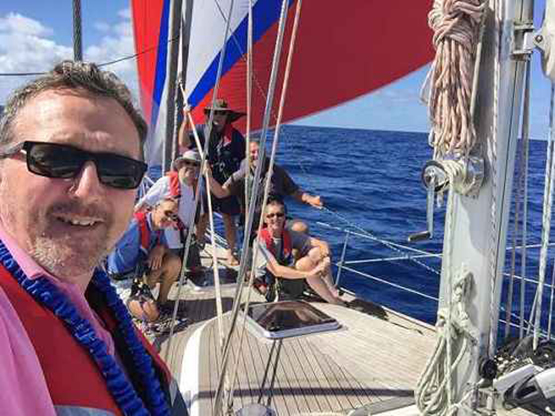With most of the cruising fleet around the half-way mark, Frank Quinn updates his earlier report on the 30th ARC Rally for cruisers that includes three Irish boats
It was a windy and lumpy start as the fleet in the 30th ARC left Las Palmas on 22 November. 25 knots, gusting 30, would be weather most coastal sailors would regard as their signal to stay in port. In the case of ocean crossings, it's business as usual -- although our skipper did comment that the start was delayed in the past under similar conditions.
Las Palmas harbour was alive with well-wishers and jostling boats for an hour before the off: the racing fleet going first, followed by the cruising division. Aboard Nina, Stephen Cooke's Nordship 43 DS, the sense of anticipation was huge as we reefed down for our first night. A quartering 10 ft swell, coupled with following 25 knot wind, kept the watches busy. With six on board, we have opted for the classic delivery crew pattern of 4 hours on/4 hours off.
Briefings in Las Palmas recommended rounding the island then making straight for St Lucia. Our skipper preferred to head south first, a decision which proved worthwhile. Although we had three days of roller-coaster sailing, we gradually picked up more even seas before we turned to the west. Here at the half way point after 13 days, we expect to make up time now that we are on the rhumb line directly to Rodney Bay.
Sailplan is a poled-out genoa with reefed main, delivering a reliable 7-8 knots. With the exception of one calm day, we have had nothing but steady 17-25 knots on our starboard quarter. On the day the wind died, we flew our cruising chute for a pleasant six hours in the sunshine. On board, life has settled into a routine around sailing, sleeping and eating. Boat systems are working well, particularly the Raymarine autohelm which is flawless -- although it relies on the generator to keep batteries alive. The only thorny issue so far has been a leaky bolt on the Hydrovane self-steering. With following seas, its transom mounting has been under pressure. Yesterday we hove-to, removed the bolts and resealed them: stern cabin floor is dry again.
We learn from the ARC reports that several boats who took the northern route suffered gear damage and diverted to the Cape Verde Islands for repair. One boat had a medical emergency and managed to hook up with a passing freighter for help.
At 1940 on Thursday (3 December) the skipper of Magritte to advised the yacht was taking on water. The source of the ingress could not be identified or stemmed and the four crew on board indicated that assistance was required as the situation worsened. On the advice of MRCC Falmouth, a MAYDAY was issued and the yacht’s EPIRB activated. The liferaft was readied in anticipation of a possible need to abandon the yacht.
MRCC Cape Verde coordinated the evacuation of the crew. Cargo vessel SCL Basilea diverted to provide assistance, reaching Magritte at approximately 0500 (UTC). The crew were safely evacuated and are all well on board SCL Basileawhich is now en route to Spain. Magritte was abandoned at approximate position 16 44.36N 027 27.82W.
What of the three Irish boats in the ARC?
Alpaire, a Hallberg-Rassy 48 skippered by Des Cummins in 634 miles to go; Crackerjack, Colum O'Sullivan's Oyster 53 has 848 miles; and BAM, Conor Fogerty's HYC-based Sun Fast 3600, among one of the smallest boats in the racing fleet, has just 600 miles to the finish line.
Reporting in from Crackerjack on December 2nd, Tralee SC's Brian O'Sullivan told Afloat.ie: 'We passed mid way point & running downwind at 7 to 8 kts all day. No sightings other than whales and flying fish for 5 days! Great on board, eta Dec 12th'
The ARC camaraderie pops up every now and again on the VHF, when AIS signals appear on nav station plotters. Not just the ARC boats: a shout came in last night from Nomad IV, a 98' yacht racing a TransAt with a crew of 17. They passed at 18 knots six miles to N, happy to chat and warning of upcoming squalls.
With our target of 150 - 180 miles a day, Nina is looking good for an overall crossing time of 21 days. The trade winds are steady, she is a fine seagoing boat and we have plenty of chocolate HobNobs on board. In the ongoing swell, this definition of the perfect seagoing cook, courtesy of author Theo Dorgan, is particularly apt:
"A fireproof, acrobatic contortionist, with a strong stomach, an ability to work fast and a distinct masochistic streak".
































































